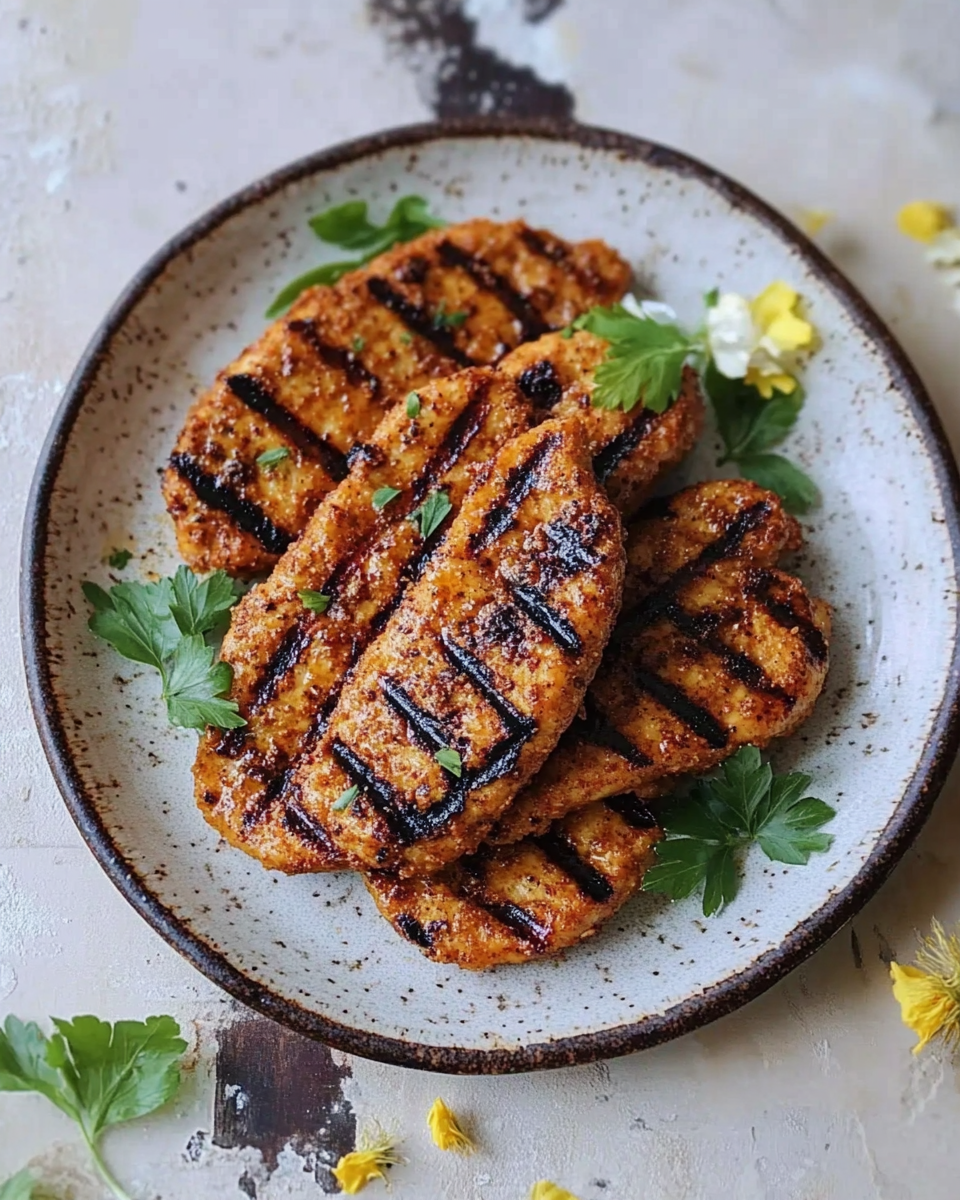Grilled Seitan Cutlets are a hearty, protein-packed plant-based dish with a smoky, savory flavor and satisfying texture. Perfect for grilling season or a quick weeknight dinner, these cutlets are marinated and grilled to perfection, offering a delicious alternative to traditional meat cutlets.
FULL RECIPE
Ingredients
- 1 pound seitan, sliced into 4 cutlets
- 1/4 cup soy sauce
- 2 tablespoons olive oil
- 2 tablespoons apple cider vinegar
- 1 tablespoon maple syrup
- 1 tablespoon tomato paste
- 2 cloves garlic, minced
- 1 teaspoon smoked paprika
- 1/2 teaspoon ground black pepper
- 1/2 teaspoon onion powder
Directions
- In a bowl, whisk together soy sauce, olive oil, vinegar, maple syrup, tomato paste, garlic, paprika, black pepper, and onion powder to make the marinade.
- Place the seitan cutlets in a shallow dish or resealable bag and pour the marinade over them. Make sure each cutlet is well coated.
- Marinate the seitan for at least 30 minutes, or up to 2 hours for more flavor.
- Preheat a grill or grill pan over medium heat.
- Remove the seitan from the marinade and grill each cutlet for 3–5 minutes per side, or until nicely charred and heated through.
- Serve hot with your favorite sides or slice for sandwiches and salads.
Nutritional Information
- Calories: 180
- Protein: 21g
- Carbohydrates: 8g
- Fat: 7g
- Fiber: 2g
- Sodium: 900mg
History and Origins of Seitan
Seitan, often called wheat meat, has a long history rooted in East Asian cuisine, particularly in China and Japan, where it has been used as a vegetarian protein source for centuries. Its development is tied closely to Buddhist vegetarian traditions, providing a meaty texture without animal products. Over time, seitan has spread globally as a versatile meat substitute.
What Is Seitan Made Of
Seitan is primarily made from gluten, the protein found in wheat. By washing wheat flour dough with water to remove the starch, the sticky, elastic gluten remains. This gluten is then cooked and flavored to create a dense, chewy product that mimics the texture of meat.
Nutritional Benefits of Seitan
Seitan is an excellent source of plant-based protein, offering about 21 grams per 100 grams serving. It is low in fat and carbohydrates and contains no cholesterol, making it a heart-healthy option. Additionally, seitan provides important minerals like iron, though it lacks some essential amino acids, so it is best paired with other plant proteins.
Why Choose Grilled Seitan Cutlets
Grilling seitan cutlets imparts a smoky flavor and slightly crispy exterior, elevating their texture and taste. The grilling process caramelizes the marinade, creating a delicious crust while keeping the interior tender and flavorful. This method also adds a healthy, oil-controlled cooking option.
Marinade and Flavor Profiles
The marinade for grilled seitan cutlets often includes soy sauce, vinegar, maple syrup, and spices like smoked paprika and garlic. These ingredients balance salty, sweet, and smoky notes, enhancing the umami qualities of seitan. The marinade penetrates the cutlets, giving depth and complexity.
Texture and Mouthfeel
Seitan’s texture is chewy and dense, resembling meat more closely than many other plant-based proteins. When grilled, the exterior gains a pleasant firmness and slight char, while the inside remains moist. This contrast creates a satisfying eating experience often missing from other vegetarian options.
Seitan vs. Other Meat Alternatives
Compared to tofu or tempeh, seitan has a more substantial, meat-like texture and a higher protein content. It holds marinades and flavors well and grills nicely without falling apart. However, it is not suitable for those with gluten intolerance or celiac disease.
Health Considerations
While seitan is nutritious, its high gluten content means it is not recommended for people with gluten sensitivity. Additionally, store-bought seitan can be high in sodium, so homemade or carefully selected varieties are preferable for low-sodium diets.
Cooking Tips for Perfect Seitan Cutlets
To get the best texture, seitan should be sliced evenly and marinated for sufficient time to absorb flavors. Grilling should be done on medium heat to prevent burning while ensuring thorough heating. Using a grill pan or outdoor grill with light oil helps achieve a good sear.
Pairing Suggestions
Grilled seitan cutlets pair well with a variety of sides, such as grilled vegetables, roasted potatoes, or fresh salads. They can also be served with dipping sauces like vegan barbecue or tahini-based dressings. For sandwiches, add fresh greens and pickled veggies for balance.
Storing and Reheating
Seitan cutlets keep well in the refrigerator for up to 3-4 days. To reheat, use a skillet or grill pan to maintain texture, avoiding microwaving which can make them rubbery. They can also be frozen for up to a month, ideally wrapped tightly to prevent freezer burn.
Versatility in Meals
Beyond grilling, seitan cutlets can be pan-fried, baked, or simmered in sauces. They are adaptable to many cuisines and recipes, from Italian to Asian-inspired dishes. Their ability to soak up flavors makes them a versatile ingredient for creative cooking.
Environmental Impact
Choosing seitan over animal meat significantly reduces environmental footprint. Wheat protein production uses less water, land, and emits fewer greenhouse gases compared to livestock farming, making grilled seitan cutlets an eco-friendly food choice.
Seitan in Vegan and Vegetarian Diets
Seitan is a staple protein source in many vegan and vegetarian diets, offering a hearty alternative to meat. It supports muscle maintenance and growth, helping to meet protein needs without animal products.
Potential Allergies and Sensitivities
Because seitan is made from wheat gluten, it is unsuitable for those with celiac disease or wheat allergies. Those with mild gluten sensitivities should approach it cautiously. Alternative meat substitutes might be preferable for these individuals.
Cultural Adaptations
In Western cuisine, seitan has been embraced as a plant-based protein that fits with grilling culture and barbecue traditions. Recipes like grilled seitan cutlets reflect a fusion of traditional Asian ingredients with contemporary American or European cooking methods.
Economic Considerations
Seitan is generally affordable, especially when made at home from basic ingredients like vital wheat gluten. Compared to many meat substitutes, it offers a budget-friendly source of protein without sacrificing taste or texture.
Homemade vs. Store-bought Seitan
Making seitan from scratch allows control over flavor and texture, reducing additives and sodium. Store-bought seitan offers convenience but often contains preservatives and flavor enhancers. Choosing quality products or homemade versions impacts the final dish’s healthfulness.
Importance of Proper Seasoning
Because seitan itself is mild in flavor, seasoning and marinades are essential to make grilled seitan cutlets tasty. Balancing salty, sweet, smoky, and acidic components creates a harmonious flavor profile that elevates the dish.
Seitan’s Role in Plant-Based Protein Trends
As plant-based eating gains popularity, seitan has become a key player in providing satisfying meat alternatives. Its adaptability and texture make it popular among flexitarians, vegetarians, and vegans looking to reduce meat consumption.
Conclusion
Grilled seitan cutlets offer a delicious, protein-rich alternative to traditional meat dishes that fits well in diverse dietary preferences. Their smoky flavor, meaty texture, and versatility make them a favorite for grilling enthusiasts and plant-based eaters alike. While not suitable for everyone due to gluten content, their nutritional benefits and environmental advantages make them a valuable addition to many diets. Whether enjoyed as a main course, sandwich filling, or salad topper, grilled seitan cutlets showcase the potential of plant-based cooking to satisfy cravings without compromise.






